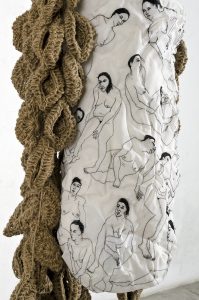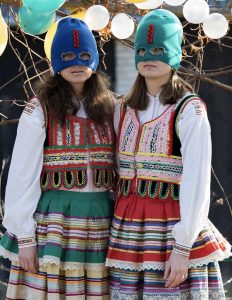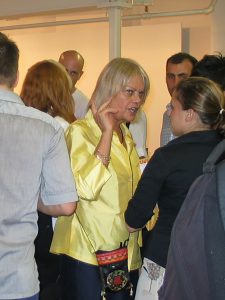Centro de las Artes, CONARTE, Monterrey | Aug – Oct, 2025
Curated by Virginie Kastel Ornielli

Miriam Medrez. Inverted Dresses (Vestidos Invertidos). 2012–2013. Series of sculptures, dim Variables. Print on fabric, embroidery, mirror, iron structure, Jute, and X-rays.
In the textile echo of Monterrey, amid industrial fibers and the metallic noise of production, Miriam Medrez builds a refuge made of threads, folds, and memory. Her exhibition Weave Unfold Pleat (Entramar, desdoblar, plisar), curated by Virginie Kastel Ornielli, unfolds as an anatomy of the Body and time; it is a rereading of matter that speaks, bends, breaks, and recomposes itself. Born in Mexico City in 1958 and based in Monterrey since 1985, Medrez has developed a steadfast, quiet, and radical practice. First came ceramics, with clay as the primary Body, the flesh of the earth; then, for the past fifteen years, textiles have become her territory —a porous skin that breathes between the domestic and the ancestral. Her transition between materials is not a migration, but a continuity; clay turns into thread, and thread into fabric matter that remembers.
In the Body of work presented in the exhibition, the verb to weave operates not as a mere technique but as a vital gesture. To weave together means to make visible the network that sustains us, the invisible genealogy of women who, through weaving, have narrated history from the margins. Inside the gallery, every work seems to hold its breath. In the series From the Earth, scraps from decorative stores are transformed into topographies that evoke cracks and abysses, wounds of the planet and the Body. What once was residue becomes a story.

Exhibition view. Right, Miriam Medrez. Who Eats Whom (¿Quién se come a quién?). 2019. Circular textile mural. Fabric, metal structure. Dim: Variable
Medrez’s work does not proclaim itself feminist, yet her practice is an act of intimate resistance and an insistence on softness within a hardened environment. In Monterrey, a city of steel and machinery, her choice of flexible materials, clay and fabric, becomes political: to “soften” space, to give form to tenderness. In this sense, the work proposes itself as a double action: to open matter and, through it, consciousness. In her piece “Who Eats Whom” (2019), a circular textile mural, the life cycle becomes a metaphor for the Body as a vegetal territory: open, permeable, and oscillating between the domestic and the wild. In Size O, the artist employs lettuce, carnivorous plants, and suspended plates to convey the social pressures on women’s bodies, diets, measurements, and control. Medrez unfolds the surface until she finds its reverse, and in that gesture reveals the psychology of the weave. What appeared as texture is also thought; the thread, a line of writing. Each fold is an interrupted phrase, a memory that insists. The exhibition, structured as a bodily map, allows her work to be read as an expansion of the intimate toward the universal.
The fold is the most radical gesture in this exhibition. Within it dwells the philosophy of the Body as vessel, as container of spirit and emotion. Following Deleuze, the fold is not only a form but a zone of indeterminacy where matter becomes thought. In her most abstract textile works, the thread gains autonomy; it becomes a structure, a body. Virginie Kastel Ornielli’s curatorship highlights this spiritual dimension of matter. Kastel, whose research on the representation of the domestic has marked her curatorial practice, understands Medrez’s work as an emotional cartography. In the exhibition, the actions of weaving, unfolding, and pleating operate as a simultaneous device: three gestures that complement each other, generating a visual multiplicity that is more felt than seen.


Miriam Medrez. Mamalia. 2012-2013. Fabric, embroidery, metal. Dim: Variable
From her early ceramic sculptures, such as the installation Trayectos, winner of the FEMSA Biennial, to her recent textile works, Medrez has conceived the Body as a vessel, a container. This concept, far removed from the Western notion of the Body as a boundary, approaches an ancestral understanding: the Body as a space of containment and transit. In works like Inverted Dresses, the dress becomes a symbolic womb. The skin, often represented through pink fabrics, appears as a living frontier between the internal and the external, between the self and the world. This conception of the Body as a bond connects with the archaic, with a matrilineal memory. In the series Mamalia, the artist establishes a dialogue between women and mammals, creating emotional portraits that rekindle the primal connection between humans and animals. The womb, time and again, appears as both landscape and refuge, a geography of intimacy that opens to the viewer like a luminous cave.
If something distinguishes Medrez’s work, it is her ability to transform the domestic into a cosmic experience. In her pieces, the sewing thread, a humble, everyday object, becomes a universal symbol of connection. Fabric is not ornament; it is structure. Art does not decorate; it repairs. To darn, in her universe, is not a minor verb it is an ethic of care. In the exhibition, this ethic is palpable in the materiality itself. The fabrics, folds, remnants, and fragments construct a narrative that oscillates between the personal and the collective. There is no rigidity or hierarchy; everything flows in a constant conversation between the figurative and the abstract. The threads behave like lines of thought, traces of a writing without fixed grammar. The artist works with the discipline of a writer, editing her sentences with her hands. Drawing, stitching, and folding are ways of saying the unsayable. In this sense, Weave Unfold Pleat proposes a reading of contemporary art from the tactile experience, from the Body’s imagination. What folds within the fabric unfolds in the viewer’s mind.

Miriam Medrez. From the Earth (Desde la Tierra). 2024–2025. Recycled fabric, thread. Height 2.40 m x Width 1.67 m
Established in Monterrey, a city where many artists leave in search of validation, Miriam Medrez has remained faithful to her place and her rhythm. Her coherent, silent practice is a form of resistance against industrial haste and the noise of spectacle. Working with fabric, with thread, with patience, is her way of insisting on the humanity of gesture. Kastel Ornielli, gathered fifteen years of textile exploration, traces a map of constancy. The exhibition is not a retrospective but a living body that breathes in the present. In each piece, the viewer encounters a vibration, a suspended story, a stitched prayer.
Thread as a Metaphor of Thought
The thread runs through the entire exhibition as a central metaphor. At times it joins; at others, it holds; at others still, it marks the scar. In the large textile murals, the line becomes topography; in the most intimate works, it transforms into emotional line.
Weave Unfold Pleat is, in the end, a reflection on matter as the mirror of the soul. Along the way, the visitor encounters a universe where softness holds power, where the body folds to contain emotion. In times of hardship, the artist reminds us that art can also be a shelter a gesture of radical tenderness. Textile, used for millennia to cover and protect, becomes here a symbol of freedom. Miriam Medrez offers us a sensory space where the body, one’s own and that of others, recognizes itself as home.

Miriam Medrez. Size Zero (Talla O). 2013. Dyed fabric, embroidery. 3.00 m x 3.00 m (variable)
Weave Unfold Pleat
Miriam Medrez
Curated by Virginie Kastel Ornielli
Centro de las Artes, CONARTE, Monterrey
August 7 – October 26, 2025
Photos courtesy of the artist.



